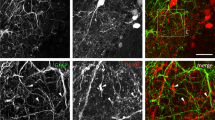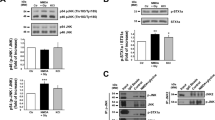Abstract
We have investigated the role of mitochondrial calcium buffering in excitotoxic cell death. Glutamate acts at NMDA receptors in cultured rat forebrain neurons to increase the intracellular free calcium concentration. Although concurrent inhibition of mitochondrial calcium uptake substantially enhanced this cytoplasmic calcium increase, it significantly reduced glutamate-stimulated neuronal cell death. Mitochondrial inhibition did not affect nitric oxide production or MAP kinase phosphorylation, which have been proposed to mediate excitotoxicity. These results indicate that very high levels of cytoplasmic calcium are not necessarily toxic to forebrain neurons, and that potential-driven uptake of calcium into mitochondria is required to trigger NMDA-receptor-stimulated neuronal death.
This is a preview of subscription content, access via your institution
Access options
Subscribe to this journal
Receive 12 print issues and online access
$209.00 per year
only $17.42 per issue
Buy this article
- Purchase on Springer Link
- Instant access to full article PDF
Prices may be subject to local taxes which are calculated during checkout






Similar content being viewed by others
References
Choi, D. W. Ionic dependence of glutamate neurotoxicity. J. Neurosci. 7, 369–379 (1987).
Tymianski, M., Charlton, M. P., Carlen, P. L. & Tator, C. H. Source specificity of early calcium neurotoxicity in cultured embryonic spinal neurons. J. Neurosci. 13, 2085–2104 (1993).
Hartley, D. M., Kurth, M. C., Bjerkness, L., Weiss, J. H. & Choi, D. W. Glutamate receptor-induced 45Ca2+ accumulation in cortical culture correlates with subsequent neuronal degeneration. J. Neurosci. 13, 1993–2000 (1993).
Dawson, V. L., Dawson, T. M., London, E. D., Bredt, D. S. & Snyder, S. H. Nitric oxide mediates glutamate neurotoxicity in primary cortical cultures. Proc. Natl Acad. Sci. USA 88, 6368–6371 (1991).
Siman, R., Noszek, J. C. & Kegerise, C. Calpain I activation is specifically related to excitatory amino acid induction of hippocampal damage. J. Neurosci. 9, 1579–1590 (1989).
Monyer, H., Hartley, D. M. & Choi, D. W. 21-aminosteroids attenuate excitotoxic neuronal injury in cortical cell cultures. Neuron 5, 121–126 (1990).
Lafon-Cazal, M., Pietri, S., Culcasi, M. & Bockaert, J. NMDA-dependent superoxide production and neurotoxicity. Nature 364, 535–537 (1993).
Coyle, J. T. & Puttfarcken, P. Oxidative stress, glutamate, and neurodegenerative disorders. Science 262, 689–695 (1993).
Dykens, J. A. Isolated cerebral and cerebellar mitochondria produce free radicals when exposed to elevated Ca2+ and Na+: implications for neurodegeneration. J. Neurochem. 63, 584–591 (1994).
Patel, M., Day, B. J., Crapo, J. D., Fridovich, I. & McNamara, J. O. Requirement for superoxide in excitotoxic cell death. Neuron 16, 345–355 (1996).
Nicholls, D. G. & Akerman, K. E. O. Mitochondrial calcium transport. Biochim. Biophys. Acta 683, 57–88 (1982).
Gunter, T. E., Gunter, K. K., Sheu, S.-S. & Gavin, C. E. Mitochondrial calcium transport: Physiological and pathological relevance. Am. J. Physiol. Cell Physiol. 267, C313–C339 (1994).
Ankarcrona, M. et al. Glutamate-induced neuronal death: a succession of necrosis or apoptosis depending on mitochondrial function. Neuron 15, 961–973 (1995).
White, R. J. & Reynolds, I. J. Mitochondrial depolarization in glutamate-stimulated neurons: An early signal specific to excitotoxin exposure. J. Neurosci. 16, 5688–5697 (1996).
Schinder, A. F., Olson, E. C., Spitzer, N. C. & Montal, M. Mitochondrial dysfunction is a primary event in glutamate neurotoxicity. J. Neurosci. 16, 6125–6133 (1996).
Gunter, T. E. & Pfeiffer, D. R. Mechanisms by which mitochondria transport calcium. Am. J. Physiol. Cell Physiol. 258, C755–C786 (1990).
Nicholls, D. G. in Molecular Mechanisms of Ischemic Brain Damage (eds Kogure, K., Hossman, K. A., Siesjö, B. K. & Welsh, F. A.) 97–106 (Elsevier, Amsterdam, 1985).
Reynolds, I. J. & Hastings, T. G. Glutamate induces the production of reactive oxygen species in cultured forebrain neurons following NMDA receptor activation. J. Neurosci. 15, 3318–3327 (1995).
Dugan, L. L. et al. Mitochondrial production of reactive oxygen species in cortical neurons following exposure to N-methyl-D-aspartate. J. Neurosci. 15, 6377–6388 (1995).
Bindokas, V. P., Jordan, J., Lee, C. C. & Miller, R. J. Superoxide production in rat hippocampal neurons: selective imaging with hydroethidine. J. Neurosci. 16, 1324–1336 (1996).
Arkles, B. & Brinigar, W. S. Respiratory properties of rat liver mitochondria immobilized on an alkylsilyated glass surface. J. Biol. Chem. 250, 8856–8862 (1975).
Wang, G. J., Richardson, S. R. & Thayer, S. A. Intracellular acidification is not a prerequisite for glutamate-triggered death of cultured hippocampal neurons. Neurosci. Lett. 186, 139–144 (1995).
Hoyt, K. R. & Reynolds, I. J. Alkalinization prolongs recovery from glutamate-induced increases in [Ca2+]i by enhancing Ca2+ efflux through the mitochondrial Na+/Ca2+ exchanger in cultured rat forebrain neurons. J. Neurochem. (in press).
Favaron, M. et al. Gangliosides prevent glutamate and kainate neurotoxicity in primary neuronal culture of neonatal rat cerebellum and cortex. Proc. Natl Acad. Sci. USA 85, 7351–7355 (1988).
Dykens, J. A., Stern, A. & Trenkner, E. Mechanism of kainate toxicity to cerebellar neurons in vitro is analogous to reperfusion tissue injury. J. Neurochem. 49, 1222–1228 (1987).
Bading, H. & Greenberg, M. E. Stimulation of protein tyrosine phosphorylation by NMDA receptor activation. Science 253, 912–914 (1991).
Kawasaki, H. et al. Activation and involvement of p38 mitogen-activated protein kinase in glutamate-induced apoptosis in rat cerebellar granule cells. J. Biol. Chem. 272, 18518–18521 (1997).
Guyton, K. Z., Liu, Y., Gorospe, M., Xu, Q. & Holbrook, N. J. Activation of mitogen-activated protein kinase by H2O2: role in cell survival following oxidant injury. J. Biol. Chem. 271, 4138–4142 (1996).
Budd, S. L. & Nicholls, D. G. Mitochondria, calcium regulation and acute glutamate excitotoxicity in cultured cerebellar granule cells. J. Neurochem. 67, 2282–2291 (1996).
Budd, S. L. & Nicholls, D. G. A reevaluation of the role of mitochondria in neuronal Ca2+ homeostasis. J. Neurochem. 66, 403–411 (1996).
Wang, G. J., Randall, R. D. & Thayer, S. A. Glutamate-induced intracellular acidification of cultured hippocampal neurons demonstrates altered energy metabolism resulting from Ca2+ loads. J. Neurophysiol. 72, 2563–2569 (1994).
Hyrc, K., Handran, S. D., Rothman, S. M. & Goldberg, M. P. Ionized intracellular calcium concentration predicts excitotoxic neuronal death: observations with low affinity fluorescent calcium indicators. J. Neurosci. 17, 6669–6677 (1997).
Stout, A. K. & Reynolds, I. J. High-affinity calcium indicators underestimate increases in intracellular calcium concentrations associated with excitotoxic glutamate stimulations. Neuroscience (in press).
Brocard, J. B., Rajdev, S. & Reynolds, I. J. Glutamate induced increases in intracellular free Mg2+ in cultured cortical neurons. Neuron 11, 751–757 (1993).
Rajdev, S. & Reynolds, I. J. Calcium green 5N, a novel fluorescent probe for monitoring high intracellular free Ca2+ concentrations associated with glutamate excitotoxicity in cultured rat brain neurons. Neurosci. Lett. 162, 149–152 (1993).
White, R. J. & Reynolds, I. J. Mitochondria accumulate Ca2+ following intense glutamate stimulation of cultured rat forebrain neurones. J. Physiol. (Lond.) 498, 31–47 (1997).
Hoyt, K. R., Stout, A. K., Cardman, J. M. & Reynolds, I. J. An evaluation of intracellular sodium and mitochondria in the buffering of kainate-induced intracellular free calcium changes in rat forebrain neurons. J. Physiol. (Lond.) 509, 103–116 (1998).
Dawson, V. L., Kizushi, V. M., Huang, P. L., Snyder, S. H. & Dawson, T. L. Resistance to neurotoxicity in cortical cultures from neuronal nitric oxide deficient mice. J. Neurosci. 16, 2479–2487 (1996).
Hewett, S. J., Corbett, J. A., McDaniel, M. L. & Choi, D. W. Inhibition of nitric oxide formation does not protect murine cortical cell cultures from N-methyl-D-aspartate neurotoxicity. Brain Res. 625, 337–341 (1993).
Pauwels, P. J. & Leysen, J. E. Blockade of nitric oxide formation does not prevent glutamate-induced neurotoxicity in neuronal cultures from rat hippocampus. Neurosci. Lett. 143, 27–30 (1992).
Demerlé-Pallardy, C., Lonchampt, M.-O., Chabrier, P.-E. & Braquet, P. Absence of implication of L-arginine/nitric oxide pathway on neuronal cell injury induced by L-glutamate or hypoxia. Biochem. Biophys. Res. Commun. 181, 456–464 (1991).
Beckman, J. S., Beckman, T. W., Chen, J., Marshall, P. A. & Freeman, B. A. Apparent hydroxyl radical production by peroxynitrite: implications for endothelial injury from nitric oxide and superoxide. Proc. Natl Acad. Sci. USA 87, 1620–1624 (1990).
Newmeyer, D. D., Farschon, D. M. & Reed, J. C. Cell-free apoptosis in Xenopus egg extracts: inhibition by Bcl-2 and requirement for an organelle fraction enriched in mitochondria. Cell 79, 189–192 (1994).
Yang, J. et al. Prevention of apoptosis by Bcl-2: release of cytochrome c from mitochondria blocked. Science 275, 1129–1132 (1997).
Susin, S.A. et al. Bcl-2 inhibits the mitochondrial release of an apoptogenic protease. J. Exp. Med. 184, 1331–1341 (1996).
Kluck, R. M., Bossy-Wetzel, E., Green, D. R. & Newmeyer, D. D. The release of cytochrome c from mitochondria: a primary site for Bcl-2 regulation of apoptosis. Science 275, 1132–1136 (1997).
Kim, C. N. et al. Overexpression of Bcl-X(L) inhibits ara-C-induced mitochondrial loss of cytochrome c and other pertubations that activate the molecular cascade of apoptosis. Cancer Res. 57, 3115–3120 (1997).
White, R. J. & Reynolds, I. J. Mitochondria and Na+/Ca2+ exchange buffer glutamate-induced calcium loads in cultured cortical neurons. J. Neurosci. 15, 1318–1328 (1995).
Bredt, D. S., Mourey, R. J. & Snyder, S. H. A simple, sensitive, and specific radioreceptor assay for inositol 1,4,5-trisphosphate in biological tissues. Biochem. Biophys. Res. Comm. 159, 976–982 (1989).
Acknowledgements
This work was supported by NIH grants NS 34138 (I.J.R.), NS 09998 (A.K.S.) and NS 34007 (E.K.). I.J.R. is an Established Investigator of the American Heart Association.
Author information
Authors and Affiliations
Corresponding author
Rights and permissions
About this article
Cite this article
Stout, A., Raphael, H., Kanterewicz, B. et al. Glutamate-induced neuron death requires mitochondrial calcium uptake. Nat Neurosci 1, 366–373 (1998). https://doi.org/10.1038/1577
Received:
Accepted:
Issue Date:
DOI: https://doi.org/10.1038/1577
This article is cited by
-
Surface-Tailored Nanoplatform for the Diagnosis and Management of Stroke: Current Strategies and Future Outlook
Molecular Neurobiology (2024)
-
Sex-dependent neuronal effects of α-synuclein reveal that GABAergic transmission is neuroprotective of sleep-controlling neurons
Cell & Bioscience (2023)
-
Excitotoxicity, calcium and mitochondria: a triad in synaptic neurodegeneration
Translational Neurodegeneration (2022)
-
Mitochondrial Ca2+ uptake by the MCU facilitates pyramidal neuron excitability and metabolism during action potential firing
Communications Biology (2022)
-
Sleep-controlling neurons are sensitive and vulnerable to multiple forms of α-synuclein: implications for the early appearance of sleeping disorders in α-synucleinopathies
Cellular and Molecular Life Sciences (2022)



